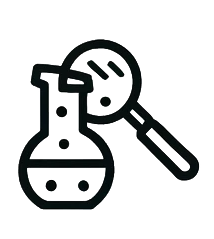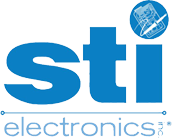STI Electronics Engineering
Microelectronics Packaging
- Advanced Design and Modeling: Utilizes sophisticated software to meet shrinking form factors and increasing thermal loads.
- Emerging Materials Evaluation: Continuously assesses new packaging materials to enhance electrical and thermal performance.
- State-of-the-Art Technologies: Specializes in cutting-edge design and assembly technologies, including Chip-On-Board (COB), Multichip Module (MCM), and Imbedded Component/Die Technology (IC/DT®).
- R&D and Advanced Equipment: Engages in extensive R&D and uses the latest equipment for developing advanced component packaging technologies.
- Class 1000 / ISO Class 6 Cleanroom: Ensures an optimal environment for microelectronics manufacturing and assembly, minimizing contamination risks.
- Storage and Handling: Employs dry nitrogen cabinets for storing PCBs, components, and wires to prevent contamination and degradation.
- Precision Dispensing and Placement: Uses sophisticated machinery for precise dispensing and component placement within ±10 μm accuracy.
- Wire Bond Interconnection: Features fully automatic ultrasonic wedge bonding with aluminum wire across a wide diameter range for diverse application needs.
- Surface Preparation: Utilizes a plasma system with a two-channel mass flow controller for optimal surface preparation for various assembly processes.
- Quality Control: Combines bond testing with high magnification visual inspection to ensure material and process integrity.
Microelectronics Packaging Lab
The Microelectronics Packaging Lab at STI was established to address the sophisticated demands of modern electronics assembly, driven by the need for advanced systems development and packaging solutions. The lab is equipped to tackle the challenges posed by increasingly compact device dimensions and heightened thermal requirements. Through ongoing research and the adoption of emerging technologies, STI remains at the forefront of the industry, capable of designing, developing, and testing robust electronics assemblies in a state-of-the-art cleanroom environment. This comprehensive setup is bolstered by top-tier equipment and expert personnel, ensuring that each component and assembly meets stringent quality standards tailored to customer specifications.

STI Electronics Engineering
Microelectronics Assembly
- Semiconductor Packaging: Techniques used to encase and protect semiconductor chips, ensuring device functionality and reliability.
- Chip & Wire Technology: A method where chips are interconnected using fine wires, typically used in high-reliability applications.
- Flip Chip Attachment: A process where the chip is inverted and connected directly to the substrate or package, enhancing electrical performance and reducing size.
- Mixed Assembly Technology: Combines various types of electronic components and technologies into a single device, improving functionality and performance.
- Multichip Modules (MCM): Incorporates multiple integrated circuits on a single package to reduce size and enhance performance.
- Package-on-Package (PoP): A packaging technique where multiple integrated circuit packages are stacked vertically, saving space and improving integration.
- System-in-Package (SiP): Integrates all components of an electronic system into one compact package, simplifying design and assembly.
- Materials Qualification: The process of testing and verifying materials to ensure they meet required specifications and quality standards.
- ISO 9001:2008 Certified: Indicates compliance with the ISO 9001:2008 standard, demonstrating a commitment to quality management practices and continuous improvement.
Microelectronics Assembly: Enhancing Functionality and Integration
Microelectronics assembly encompasses a range of sophisticated techniques aimed at integrating and enhancing the functionality of electronic devices. From advanced semiconductor packaging to innovative chip connection methods like chip & wire and flip chip attachment, these techniques are crucial for developing compact and high-performance electronic products. Technologies such as mixed assembly, multichip modules, package-on-package, and system-in-package allow for significant advancements in how electronic components are combined and housed. Additionally, materials qualification ensures that all components meet stringent quality standards, while adherence to ISO 9001:2008 certification confirms a dedication to maintaining the highest levels of quality management and organizational efficiency. Together, these capabilities represent a comprehensive approach to modern microelectronics assembly, crucial for keeping pace with the demands of advanced electronic systems.

STI Electronics Engineering
Imbedded Die Engineering (IC/DT®)
- Smallest Form and Fit Factor: Achieves highly compact device dimensions through innovative design and integration techniques.
- Low Stress Interconnect Attach: Utilizes connection methods that minimize mechanical stress on components, enhancing durability and reliability.
- Passive Thermal Management: Incorporates features that naturally dissipate heat without the need for active cooling systems, improving device longevity.
- Stress Compliant Materials: Employs materials that are specifically chosen for their ability to withstand mechanical and thermal stress, reducing the risk of material fatigue.
- Reduced Failure Opportunity: Designs and materials choices that inherently lower the chances of component and system failures.
Imbedded Die Engineering (IC/DT®): Advancing Microelectronics Integration
Imbedded Die Engineering, featuring the patented IC/DT® technology, focuses on integrating die within substrates to achieve the smallest possible form and fit factors in electronic devices. This engineering approach not only minimizes the physical footprint of devices but also incorporates advanced techniques such as low stress interconnect attachments and the use of stress compliant materials. These features are critical for enhancing the mechanical and thermal robustness of the microelectronics, thereby reducing potential failure opportunities. Passive thermal management further ensures the devices operate within safe temperature ranges, extending their operational life. Collectively, these innovations in Imbedded Die Engineering facilitate the development of highly reliable and efficient electronic systems suited for today's demanding applications.

STI Electronics Engineering
Ultrasonic / Thermasonic
Wire Bond
- Aluminum Ultrasonic Wedge Bonding: Utilizes ultrasonic energy to form bonds between aluminum wires and contact pads, offering strong mechanical and electrical connections.
- Gold Thermosonic Ball Bonding: Employs a combination of heat, pressure, and ultrasonic energy to create spherical bonds using gold wire, enhancing device reliability.
- Ribbon Bonding: Involves using flat, thin metal ribbons to create larger surface area bonds, suitable for high power applications due to improved current carrying capacity.
Ultrasonic / Thermasonic Wire Bonding: Enhancing Microelectronic Connections
Ultrasonic and thermasonic wire bonding technologies are essential for creating strong and reliable interconnections in microelectronic devices. Aluminum ultrasonic wedge bonding and gold thermosonic ball bonding are two prominent techniques that leverage the unique properties of aluminum and gold, respectively, to form durable bonds. Aluminum ultrasonic wedge bonding is noted for its efficiency and strength in connections, making it ideal for a wide range of electronic applications. Gold thermosonic ball bonding, on the other hand, utilizes the excellent conductivity and ductility of gold, combined with thermal and ultrasonic energy, to ensure high-quality bonds that are crucial for the long-term reliability of electronic components. Ribbon bonding further extends the capabilities of these techniques by offering a solution for high-power requirements through larger bondable surface areas, thus supporting a broader spectrum of electronic assembly needs. These bonding methods are critical in the assembly of devices requiring precise, robust, and reliable electrical connections.

STI Electronics Engineering
Flip Chip Assembly
- Direct Chip Attach (DCA): Involves mounting semiconductor chips directly onto substrates or circuit boards, maximizing space efficiency and enhancing signal transmission.
- Lead-Free Interconnect: Utilizes non-lead-based materials for chip connections, aligning with environmental regulations and reducing health risks.
- Eutectic 63Sn37Pb Interconnect: Employs a solder composed of 63% tin and 37% lead, known for its reliable melting point and strong bond formation.
- High Lead Interconnect: Features interconnects with a high percentage of lead, offering robust thermal fatigue resistance, suitable for high-temperature applications.
- Anisotropic Conductive Adhesive Interconnect: Uses adhesives filled with conductive particles that enable electrical connection only in specific directions, ideal for fine-pitch applications.
- Underfill Encapsulation: Applies a resin between the chip and substrate, filling gaps and reinforcing the chip's mechanical stability and thermal cycling performance.
Flip Chip Assembly: Advanced Techniques for Efficient Interconnections
Flip chip assembly represents a sophisticated method in microelectronics manufacturing, aimed at optimizing the efficiency and performance of electronic devices. This technique includes various innovative interconnect approaches such as Direct Chip Attach (DCA), which allows for direct mounting of chips on substrates to enhance circuit density and signal integrity. Environmentally conscious and health-compliant lead-free interconnects are increasingly adopted, alongside traditional eutectic and high lead interconnects, which provide specific advantages in terms of melting behavior and thermal resistance, respectively. Anisotropic Conductive Adhesive Interconnects offer targeted conductivity for precise applications, while underfill encapsulation enhances the durability and reliability of the chip by protecting against mechanical and thermal stresses. Each of these technologies contributes to the robust, efficient, and versatile construction of modern electronic components and systems

STI Electronics Engineering
Thermal Optimization
- Passive Cooling Design: Focuses on cooling electronic components without the use of external power, relying on natural heat dissipation methods such as heat sinks and convection.
- Thermal Material Selection: Involves choosing materials that have optimal thermal conductivity properties to enhance heat transfer and reduce thermal resistance in electronic devices.
- Thermography Testing: Employs infrared cameras and other imaging equipment to visually monitor and measure the heat patterns and temperatures across electronic components, identifying potential overheating issues.
Thermal Optimization: Enhancing Device Longevity and Performance
Thermal optimization is crucial in electronics design to ensure devices operate within safe temperature ranges, thereby enhancing performance and extending lifespan. Key strategies include passive cooling design, which maximizes natural heat dissipation without additional energy consumption. This is complemented by strategic thermal material selection, where materials are chosen based on their ability to efficiently conduct and transfer heat. Additionally, thermography testing is employed to provide a visual assessment of thermal performance, pinpointing hot spots and areas of inefficiency that might compromise component integrity or function. Together, these approaches form a comprehensive thermal management strategy that helps maintain optimal operating temperatures and prevents thermal-related failures in electronic devices.

STI Electronics Engineering
Cleanroom (Class 1000/ISO Class 6)
- ISO 14644-1 Certification to ISO Class 6: Ensures that the cleanroom meets specific international standards for particle concentration, maintaining a highly controlled environment suitable for sensitive manufacturing processes.
- Controlled Temperature/Humidity Environment: Regulates the cleanroom's temperature and humidity to prevent environmental variations that could affect product quality or cause damage.
- Ionizer/Dissipative Flooring ESD Control: Incorporates systems to minimize static electricity, protecting sensitive electronic components from electrostatic discharge (ESD) during manufacturing and assembly.
Cleanroom (Class 1000/ISO Class 6): Precision Environment for Microelectronics Production
A Class 1000/ISO Class 6 cleanroom is designed to provide an optimal controlled environment for the production and assembly of microelectronics, particularly during prototype development and low volume manufacturing. This environment is meticulously regulated to meet ISO 14644-1 standards, ensuring minimal particle contamination. Key features include controlled temperature and humidity settings to stabilize the production conditions and prevent material degradation. Additionally, the cleanroom is equipped with ionizer and dissipative flooring for effective ESD control, crucial for protecting electronic components from static damage. These features, combined with advanced manufacturing equipment like sophisticated dispenser/placement machines and ultrasonic wedge bonders, ensure high precision and reliability in the assembly of complex electronic devices.

STI Electronics Engineering
Informational Brochure - download



